This post was first published on 19th August, 2014.
Every blind person aspires to live a life of independence, a life of freedom and free will, a life free from intrusion, physical and psychological. Some patented inventions have attempted to enhance this very independence, and I will, in my upcoming posts, endeavor to take an unbiased look at some of them.
In 1991, Hsieh Chi-Sheng filed a patent for an electronic talking stick for the blind. Before we get into details, one must understand the role of a stick, or cane, in a blind man’s life. It is, simply put, the most important tool for mobility. In other words, it is one irreplaceable tool, which helps a person get around. Without it, most blind people are literally disabled. It sees many things one cannot.
Having said that, a simple stick has some limitations:
a. It cannot spot top level objects such as low lying branches, etc, which are the cause for bumps on faces; and
b. It often misses out on manholes, for which there is no dearth in India.
Many have tried to solve these problems, and Hsie’s invention, whose patent has now expired, is one of them. His patent, US 5097856, claims an electronic talking stick, which will instruct a blind man to walk and go upstairs and downstairs, and warn him of dangerous depressions in the road, and which calls for help when a blind man who uses the stick falls, not an uncommon occurance.
The stick has a supporting rod, a control box, a handle, a free steering caster, and a horizontal scanning device, in which the free steering caster helps the whole assembly to slide; two detectors in the control box and a range finder and moving object detector in the handle are arranged for trouble detection to let detected signals be converted into voice, by means of the processing through a control circuit, to instruct the user through an earphone connected to the handle.
For benefit of persons with less than ordinary skill in the art, people like me, the ordinary stick has a scanning device, a detector, and a mechanism of converting these signals into voice commands. Practically, if I am using this stick, I will have a slightly heavy stick with a couple of gadgets attached to it, and a set of ear phones connected from the stick to my ears. Whenever there is an objectionable object, the stick will tell me, and I duck, swerve, or reverse. It will also tell me if I fall down, quite illuminating.
Let us see how this works. Assume that I am walking on the road, an Indian road, with no sidewalks, lots of pot holes, rugged edges, bent poles, low lying branches and some road humps to our benefit. As I had brought out in one of my earlier posts, and my first novel also, road humps are sign posts for the blind, and there is no dearth of them, at least in Bangalore. Now, let us assume that a pothole comes up, the electronic lady in the stick will warn me that there is a depression. What do I do now – Stop, Pull out my ear phone, and listen carefully to the sounds on the road.
I don’t hear anything, hopefully, one of those silent vehicles sold by Reva, or an over zealously silenced engine, or a soundless danger is not around, and I decide to take a right turn, left would mean moving off the road. Now, plug my ear phones back, and scan once again using my electronic talking stick. The lady does not speak, and that is good news, no obstacles on the road. Hoping that she is not lying, or dumb enough to not spot a pothole, I move on to the road, taking a reasonable risk. Then, I straighten, take a few steps and turn left again. This time, I don’t have to pull out ear phones for road sounds because I am going off the road, to what is supposed to be a foot path.
But, I don’t just walk back to my original track, I wait, scan to find out if I have passed the depression, and if the lady is silent, get back and get going. No wonder, it takes me double, some times triple the time, to reach my destination, when I am alone. However useful the invention might sound, these sticks can only spot thirty percent of obstacles on Indian roads, and I would assume US/European roads as well, and the ear phones/voice can have great nuisance value. Instead, one is better off, listening to a radio, or one of the entertaining Personal Digital Assistants (PDAs). After all, a fall once in a while is inevitable.
So, I am not surprised that during the term, and now after the patent’s expiry, we do not see these electronic talking sticks around. So much for the independence they carry with them!




0 Comments
Mobility Aid
Hey, very nice site. I came across this on Google, and I am stoked that I did. I will definitely be coming back here more often. Wish I could add to the conversation and bring a bit more to the table, but am just taking in as much info as I can at the moment. Thanks for sharing.
Keep Posting:)
Mobility Aid
Nice site, It strikes a nice balance of the concept. I had a natural tendency towards ‘mindfulness’ from a young age. I am glad that I will definitely be coming back here more often. Wish I could add to the conversation. Thanks for sharing.
Walking Canes
Keep Posting:)